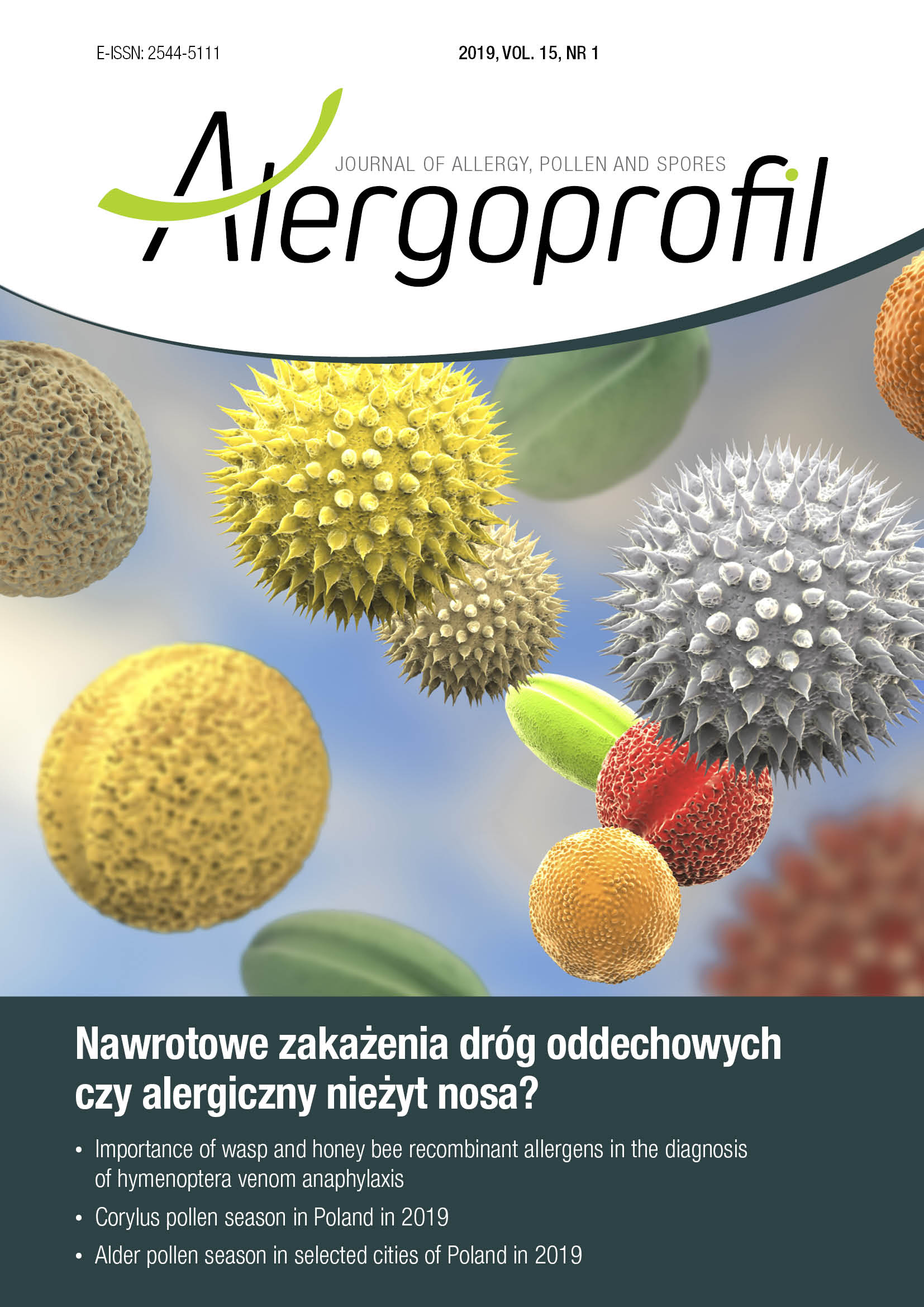Importance of wasp and honey bee recombinant allergens in the diagnosis of hymenoptera venom anaphylaxis
##plugins.themes.bootstrap3.article.main##
Abstrakt
Background: Hymenoptera venom-allergic patients frequently present multiple sensitisations.
Objectives: To define the allergic profile by components in Hymenoptera venom allergic patients. To study the usefulness of specific IgE to components in cases of negative results of sIgE to the venoms. Patients (n = 86) with a diagnosis of allergic systemic reaction following honey bee or wasp stings were included in the study. Skin prick tests (SPT) and intradermal reaction were performed. sIgE to complete extracts of honey bee (Apis mellifera), Vespula (Vespula spp.), venom and recombinant allergens rApi m1, rApi m 5; rVes v5 and rVes v1 5 were analysed by ImmunoCAP (Phadia). sIgE concentration higher than 0.35 kU/l were considered positive.
Results: 86 patients (40 male, 46 female) were included. No sIgE to Honey bee/Vespula was detected in 15 patients. In 7 of them only component diagnosis (Api m1 and Ves v5) confirmed hymenoptera allergy. Positive correlation between severity of anaphylactic reaction and sIgE to rVes v1 concentration was observed (r = 0,85; p < 0.05) and sIgE to rApi m1 (r = 0.87; p < 0.05). None such correlation was observed with specific IgE to other venom components.
Conclusions: Components analysis can be useful to make diagnosis more accurate. Determination of sIgE towards phospholipase A2 (Apis mellifera) and phospholipase A1 (Vespula spp.) may reflects severity of allergic reaction after hymenoptera sting.
Pobrania
##plugins.themes.bootstrap3.article.details##
Copyright: © Medical Education sp. z o.o. This is an Open Access article distributed under the terms of the Attribution-NonCommercial 4.0 International (CC BY-NC 4.0). License (https://creativecommons.org/licenses/by-nc/4.0/), allowing third parties to copy and redistribute the material in any medium or format and to remix, transform, and build upon the material, provided the original work is properly cited and states its license.
Address reprint requests to: Medical Education, Marcin Kuźma (marcin.kuzma@mededu.pl)
Bibliografia
2. Wood RA, Camargo Jr CA, Lieberman P et al. Anaphylaxis in America: The prevalence and characteristics of anaphylaxis in the United States. J Allergy Clin Immunol 2014, 133: 461-467.
3. Mullins RJ, Dear KBG, Tang MLK. Time trends in Australian hospital anaphylaxis admissions in 1998–1999 to 2011–2012. J Allergy Clin Immunol 2015, 136: 367-375.
4. Turner PJ, Gowland MH, Sharma V et al. Increase in anaphylaxis-related hospitalizations but no increase in fatalities: An analysis of United Kingdom national anaphylaxis data, 1992–2012. J Allergy Clin Immunol 2015, 135: 956-963.
5. Stewart AG, Ewan PW. The incidence, aetiology and management of anaphylaxis presenting to an accident and emergency department. QJM 1996, 89: 859-864.
6. Bilo MB, Bonifazi F. The natural history and epidemiology of insect venom allergy: clinical implications. Clin Exp Allergy 2009, 39: 1467-1476.
7. WHO/IUIS Allergen Nomenclature-subcommettee database[online: http://www.alergen.org].
8. Simons FE, Ardusso LRF, Bilo MB et al. 2015 update of the evidence base: World Allergy Organization anaphylaxis guidelines. World Allergy Organ J 2015, 8: 32. https://doi.org/10.1186/ s40413-015-0080-1.
9. Golden DBK, Kagey-Sobotka A, Norman PS et al. Insect sting allergy with negative venom skin test responses. J Allergy Clin Immunol 2001, 107: 897-901.
10. Kontou-Fili K. Patients with negative skin tests. Curr Opin Allergy Clin Immunol 2002, 2: 353-357.
11. Jappe U, Raulf-Heimsoth M, Hoffmann M et al. In vitro Hymenoptera venom allergy diagnosis: improved by screening for cross-reactive carbohydrate determinants and reciprocal inhibition. Allergy 2006, 61: 1220-1229.
12. Jakob T, Kohler J, Blank S et al. Comparable IgE reactivity to natural and recombinant Api m 1 in cross-reactive carbohydrate determinant-negative patients with bee venom allergy. J Allergy Clin Immunol 2012, 130: 276-278.
13. Seismann H, Blank S, Braren I et al. Dissecting cross-reactivity in hymenoptera venom allergy by circumvention of alpha-1,3-core fucosylation. Mol Immunol 2010, 47: 799-808.
14. Muller U, Johansen N, Petersen A et al. Hymenoptera venom allergy: analysis of double positivity to honey bee and Vespula venom by estimation of IgE antibodies to species specific major allergens Api m 1 and Ves v. Allergy 2009, 64: 543-548.
15. Ruiz B, Serrano P, Moreno C. IgE-Api m 4 is useful for identifying a particular phenotype of bee venom allergy. J Investig Allergol Clin Immunol 2016, 26: 355-361.
16. Vos B, Koehler J, Euller SM et al. Spiking venom with rVes v 5 improves sensitivity of IgE detection in patients with allergy to Vespula venom. J Allergy Clin Immunol 2012, 131: 1225-1227.
17. Sturm GJ, Hemmer W, Hawranek T et al. Detection of IgE to recombinant Api m 1 and rVes v 5 is valuable but not sufficient to distinguish bee from wasp venom allergy. J Allergy Clin Immunol 2011, 128: 247-248.
18. Arzt L, Bokanovic D, Schrautzer C et al. Questionable diagnostic benefit of the commercially available panel of bee venom components. Allergy 2017, 72(9): 1419-1422.

